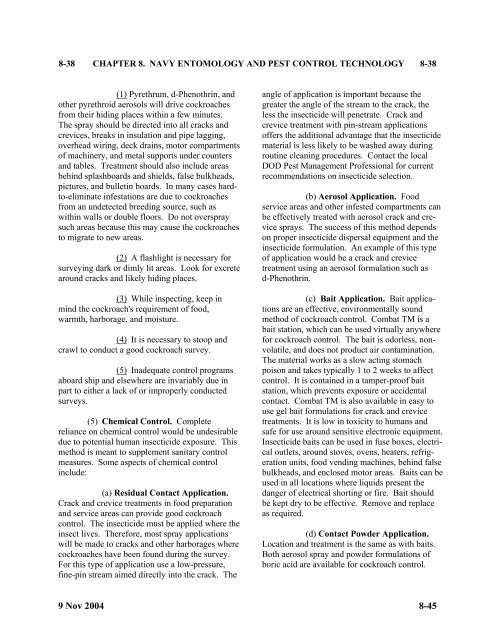NAVMED P-5010-8 - Navy Medicine - U.S. Navy
NAVMED P-5010-8 - Navy Medicine - U.S. Navy
NAVMED P-5010-8 - Navy Medicine - U.S. Navy
You also want an ePaper? Increase the reach of your titles
YUMPU automatically turns print PDFs into web optimized ePapers that Google loves.
8-38 CHAPTER 8. NAVY ENTOMOLOGY AND PEST CONTROL TECHNOLOGY 8-38<br />
(1) Pyrethrum, d-Phenothrin, and<br />
other pyrethroid aerosols will drive cockroaches<br />
from their hiding places within a few minutes.<br />
The spray should be directed into all cracks and<br />
crevices, breaks in insulation and pipe lagging,<br />
overhead wiring, deck drains, motor compartments<br />
of machinery, and metal supports under counters<br />
and tables. Treatment should also include areas<br />
behind splashboards and shields, false bulkheads,<br />
pictures, and bulletin boards. In many cases hardto-eliminate<br />
infestations are due to cockroaches<br />
from an undetected breeding source, such as<br />
within walls or double floors. Do not overspray<br />
such areas because this may cause the cockroaches<br />
to migrate to new areas.<br />
(2) A flashlight is necessary for<br />
surveying dark or dimly lit areas. Look for excrete<br />
around cracks and likely hiding places.<br />
(3) While inspecting, keep in<br />
mind the cockroach's requirement of food,<br />
warmth, harborage, and moisture.<br />
(4) It is necessary to stoop and<br />
crawl to conduct a good cockroach survey.<br />
(5) Inadequate control programs<br />
aboard ship and elsewhere are invariably due in<br />
part to either a lack of or improperly conducted<br />
surveys.<br />
(5) Chemical Control. Complete<br />
reliance on chemical control would be undesirable<br />
due to potential human insecticide exposure. This<br />
method is meant to supplement sanitary control<br />
measures. Some aspects of chemical control<br />
include:<br />
(a) Residual Contact Application.<br />
Crack and crevice treatments in food preparation<br />
and service areas can provide good cockroach<br />
control. The insecticide must be applied where the<br />
insect lives. Therefore, most spray applications<br />
will be made to cracks and other harborages where<br />
cockroaches have been found during the survey.<br />
For this type of application use a low-pressure,<br />
fine-pin stream aimed directly into the crack. The<br />
angle of application is important because the<br />
greater the angle of the stream to the crack, the<br />
less the insecticide will penetrate. Crack and<br />
crevice treatment with pin-stream applications<br />
offers the additional advantage that the insecticide<br />
material is less likely to be washed away during<br />
routine cleaning procedures. Contact the local<br />
DOD Pest Management Professional for current<br />
recommendations on insecticide selection.<br />
(b) Aerosol Application. Food<br />
service areas and other infested compartments can<br />
be effectively treated with aerosol crack and crevice<br />
sprays. The success of this method depends<br />
on proper insecticide dispersal equipment and the<br />
insecticide formulation. An example of this type<br />
of application would be a crack and crevice<br />
treatment using an aerosol formulation such as<br />
d-Phenothrin.<br />
(c) Bait Application. Bait applications<br />
are an effective, environmentally sound<br />
method of cockroach control. Combat TM is a<br />
bait station, which can be used virtually anywhere<br />
for cockroach control. The bait is odorless, nonvolatile,<br />
and does not product air contamination.<br />
The material works as a slow acting stomach<br />
poison and takes typically 1 to 2 weeks to affect<br />
control. It is contained in a tamper-proof bait<br />
station, which prevents exposure or accidental<br />
contact. Combat TM is also available in easy to<br />
use gel bait formulations for crack and crevice<br />
treatments. It is low in toxicity to humans and<br />
safe for use around sensitive electronic equipment.<br />
Insecticide baits can be used in fuse boxes, electrical<br />
outlets, around stoves, ovens, heaters, refrigeration<br />
units, food vending machines, behind false<br />
bulkheads, and enclosed motor areas. Baits can be<br />
used in all locations where liquids present the<br />
danger of electrical shorting or fire. Bait should<br />
be kept dry to be effective. Remove and replace<br />
as required.<br />
(d) Contact Powder Application.<br />
Location and treatment is the same as with baits.<br />
Both aerosol spray and powder formulations of<br />
boric acid are available for cockroach control.<br />
9 Nov 2004<br />
8-45
















